The Samsung Galaxy S7 and S7 edge Review: Part 2
by Joshua Ho on July 5, 2016 8:00 AM ESTCamera Architecture and UX
In general, camera has become probably the single biggest point of differentiation between smartphones at this point. As smartphones are often the only camera that most people carry on a day to day basis, the rear camera on a smartphone really cannot be a disappointment relative to the competition. While we can talk about how much a front-facing camera matters in terms of quality, it’s pretty safe to say that for photos and videos that are worth saving will be taken with the rear-facing camera.
While post-processing and a number of other factors are going to have a huge impact on the overall camera experience, the foundation that makes it possible to deliver a great camera is always going to start at the hardware.
| Samsung Galaxy S Cameras | ||||
| Galaxy S6 Galaxy Note5 |
Galaxy S7 | |||
| Front Camera | 5.0MP | 5.0MP | ||
| Front Camera - Sensor | Samsung S5K4E6 (1.34 µm, 1/4.1") |
Samsung S5K4E6 (1.34 µm, 1/4.1") |
||
| Front Camera - Focal Length | 2.2mm (22mm eff) | 2.1mm (21mm eff) | ||
| Front Camera - Max Aperture | F/1.9 | F/1.7 | ||
| Rear Camera | 16MP | 12MP | ||
| Rear Camera - Sensor | Sony IMX240 Samsung S5K2P2 (1.12 µm, 1/2.6") |
Sony IMX260 Samsung S5K2L1 (1.4 µm, 1/2.6") |
||
| Rear Camera - Focal Length | 4.3mm (28mm eff) | 4.2mm (26mm eff) | ||
| Rear Camera - Max Aperture | F/1.9 | F/1.7 | ||
In the case of the Galaxy S7, Samsung has done something that I thought they’d never do, which is move backwards in resolution in order to improve pixel sensitivity. In the case of the Galaxy S7, Samsung has moved from the Sony IMX240/Samsung S5K2P2 to the Sony IMX260/Samsung S5K2L1 sensor, with a 1.4 micron pixel size relative to a 1.12 micron pixel pitch in the previous generation. This means that there’s a 56% increase in sensitivity per pixel. Assuming the same process technology, this does improve low light performance significantly. While to some extent it’s true that improved CIS (CMOS image sensor) technology can alleviate the downsides of smaller pixels, on the same technology you have to reduce your fill factor/active sensor area. The other problem is that while read noise on the sensor does reduce per pixel as you reduce pixel size, the overall sensor read noise trends upwards. This means that the region in which the CIS noise is primarily limited by shot noise is going to be smaller as you reduce pixel size. Shot noise is an unavoidable reality of existence, to the extent that even our eyes can see this “visual snow” if ambient light is sufficiently dim.
However, in the case of the Galaxy S7 I suspect that there’s more to the story, because the dual pixel AF system means that for each 1.4 micron pixel each pixel needs two photodetectors. In order to make phase detection work, there has to be sufficient spatial separation to make this system work properly, so some of the benefit of these larger pixels will inevitably be eaten up in order to enable PDAF that works in basically all lighting conditions.
The other notable change here is that the Galaxy S7 uses an even wider f/1.7 aperture. Unfortunately, in Samsung's efforts to try and make the module thinner they've made the focal length slightly shorter than before which results in an effective focal length of 26mm. This and the wider aperture could lead to compromises as light is entering the optics at a more extreme angle than before.
With these basics covered, we can move on to a discussion of the user experience. While in the past it was easy enough to just take some still shots on a tripod, a holistic view of camera quality really needs to take into account far more than just the end result. A poorly designed camera application with low resolution, low frame rate preview, improper preview aspect ratio, poor control layout, and other issues can easily make it difficult, if not impossible to get the photo that you want. These issues are thankfully getting less common, but these problems can make it almost impossible to recommend a phone for its camera, no matter how good the results are.
In the case of the Galaxy S7, the camera application is a nice upgrade over the Galaxy S6 at launch, but for the most part nothing is really different this go around. I’m not going to spend too much time here, but the short story is that I don’t think that Samsung is doing anything wrong here, and things are pretty much as good as they’re going to get.
While leaving it at that would be enough, I want to recognize some of the improvements that Samsung has implemented here. The major improvement here is that Pro mode is finally useful, as this mode now allows for adjusting auto-exposure and AF targets, in addition to EV, shutter speed, ISO, white balance with 100K granularity, and manual focus. The one notable shortfall here is that Samsung only allows 800 ISO max in manual ISO mode when the true maximum is 1250. For better or worse though, that’s the only notable problem I encountered with the camera app itself. It’s easy to think that Samsung hasn’t done anything notable here, but this is more a testament to the execution of design more than anything else.
However, before we move on to image quality testing, we can take a look at our focus and capture latency tests. For those that are unfamiliar, this is a fairly simple test designed to see how long it takes for a phone to focus and capture a scene on our standard ISO test chart in good lighting conditions, which can give a fairly good idea for best case latencies.
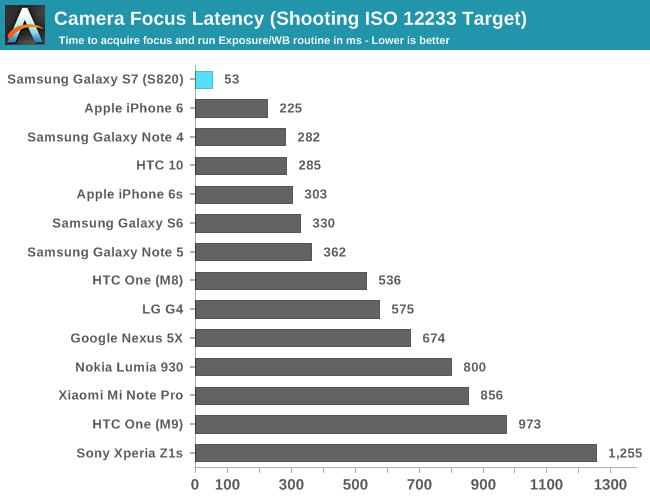
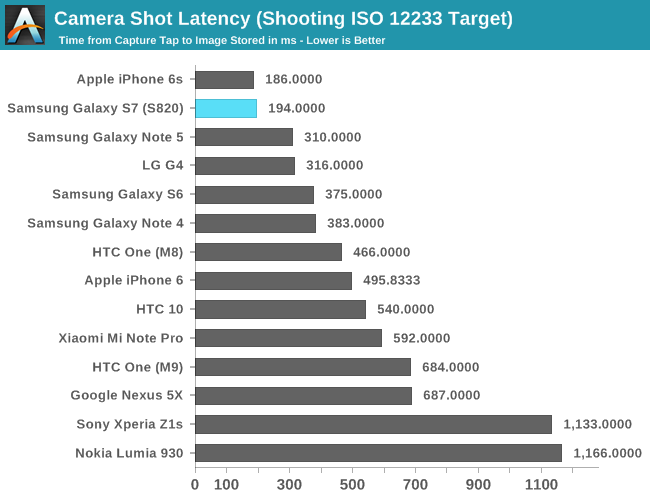
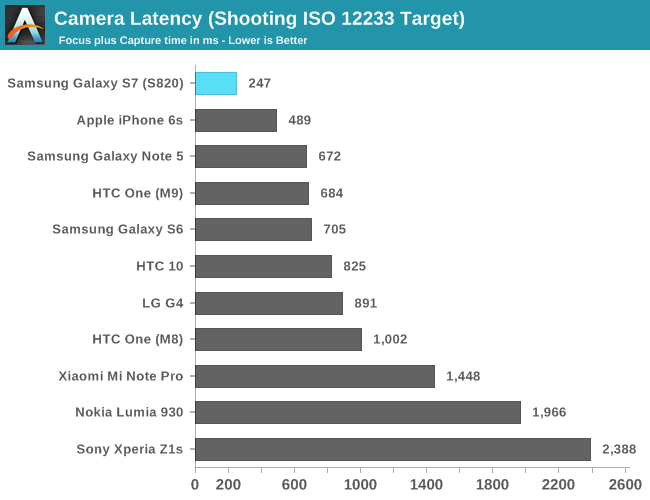
It’s probably not a surprise, but the Galaxy S7 is really, absurdly quick to take photos and focus. There is nothing out there that can realistically match the dual pixel AF system in the Galaxy S7, especially once you get into low light scenarios where traditional PDAF systems are overwhelmed by noise that can’t be easily canceled out. Samsung’s sheer prowess in semiconductor design and manufacture is really showing here, even in the best case.


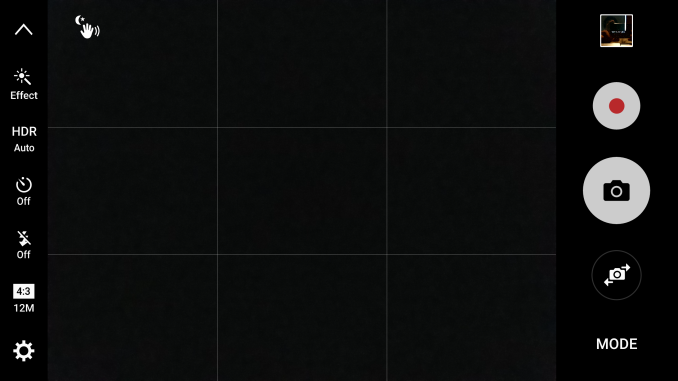
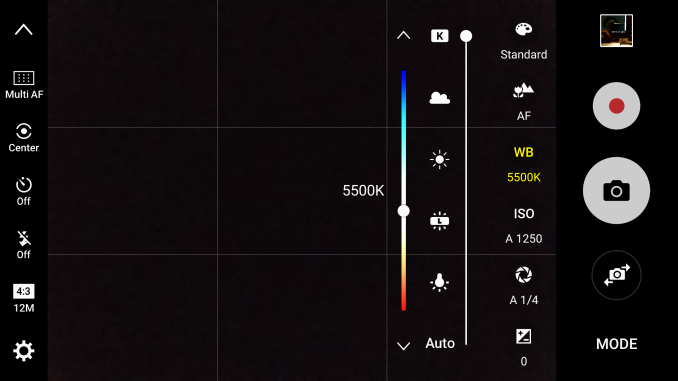
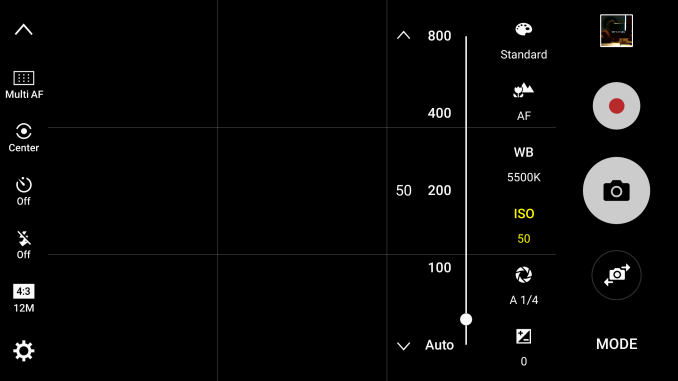








266 Comments
View All Comments
realbabilu - Thursday, July 7, 2016 - link
I wish AT can check the touchscreen latency between these mobile. Sometimes you got powerful chip but still some lags noticeable.I want to see where the real apps excluding the benchmark app that can utilize all Cores and where the cpu can use smart management where the app need use all power and which not. Simple that sometimes a 2D games like
Air attack 2 could raise temperature very high. Smart management cpu may decrease the power that doesn't needed for those apps.
Good review. And nice to review high end to cheap Chinese phones, so we can now where it pays..
Magicpork - Thursday, July 7, 2016 - link
So it took them 4 months to write up an Apple Biased review... no wonder the reputation of anandtech has fallen so much recently..KoolAidMan1 - Sunday, July 10, 2016 - link
This comment section taught me that reality is biased.Instead of being mad at Anandtech that a GS7 got BTFO by an iPhone SE, maybe you should demand more from Google and OEMs to improve their hardware and operating system.
Ihabo - Thursday, July 7, 2016 - link
Galaxy S7 Edge Wins In:+IPS68 Water & Dust Resistant
+Quad HD Super Amoled Screen ( brighter under sun light ) and immersive
+Dual Pixel New Technology Camera - Very Fast in Auto Focus & Low Light
+3,600mAh Battery last one day easily of heavy usage
+Exynos8890 Better than SnapDragon 820 in Battery Performance.
+Wireless Charging
+No Heat while fast charging
Phone of the Year no Doubt
beggerking@yahoo.com - Monday, July 11, 2016 - link
now only if they'd bring removable battery back... then i'd be all over it.still keeping my s5 for the time being.
AJP - Thursday, July 7, 2016 - link
Regarding the Galaxy S7 and S7 Edge Review, when comparing benchmarks please take into account the APPLE Iphone screen resolutions are much lower. That will bias the results in their favour and should be considered before making any comments.blackcrayon - Thursday, July 7, 2016 - link
Did you even read the review? For as long as I can remember, they've been showing both onscreen and offscreen GPU benchmarks for this very reason. And they specifically mention it in the review that the iPhone GPU keeps up on-screen because of the lower resolution.As for the CPU benchmarks, it comes down to Apple's really high single core performance and optimized browser engine. One advantage of designing both the hardware and all of the software in tandem.
JoeDuarte - Thursday, July 7, 2016 - link
Does anyone know what the author means by Google's optimizations - or lack thereof - for Chrome on Android? What optimizations? Does Google normally do something special? I don't understand what he's referring to.Also, what does he mean by Samsung's lack of optimization of the UI? Is there a standard set of optimizations that OEMs do on Android phones? Is he talking about low level C code, or ARM assembly or something?
Impulses - Thursday, July 7, 2016 - link
In the case of the browser, there's optimizations other browsers can and have done for specific SoC, it used to be a lot more common before Chrome for Android being the stock browser tho it's still prevalent... I'm guessing for whatever reason Google has never implemented such hardware specific optimizations.In the case of the UI, there's a lot of Samsung elements added atop the base OS that do drag performance down, other OEM have scaled back their OS customizations or fine tuned then over time (namely Moto and HTC to an extent)... Samsung's approach is still pretty heavy handed.
UltraWide - Thursday, July 7, 2016 - link
"Samsung is better than anybody else at learning from its competitors. "A market reader is sort of the classic fast follower," explains Barry Jaruzelski, senior partner at Booz&Co and the co-author of the Global Innovation 1000. "It doesn't mean they ignore their customers, but they're very attuned to what competitors are doing and what other people are bringing to market first and observing what seems to be gaining traction, then very rapidly coming up with their own version of that innovation."http://www.businessinsider.com/samsung-corporate-s...
That's always been Samsung's strength, it will take time to change the whole corporation's mantra.